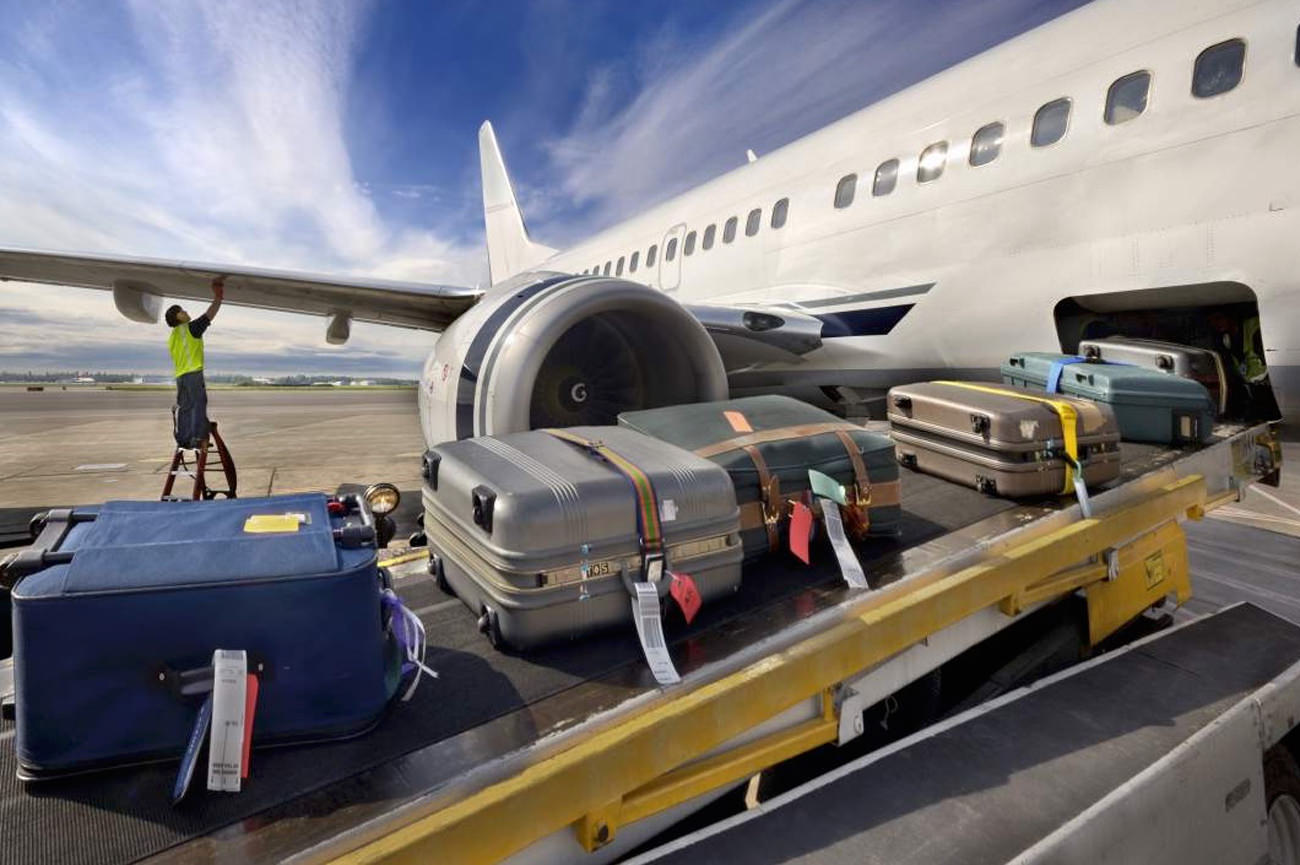Have Trombone, Will Travel?
Thoughts on flying with your instrument in tow…
I’ve spent quite a bit of time travelling with my trombone over the last few years. Pretty near every week involved some sort of trip to the airport, and although this coming year is looking far less complicated in that regard, I’m still going to be enjoying ginger ale and pretzels served by Air Canada on a fairly frequent basis.
A recent blog post by Boston Symphony principal trombonist Toby Oft brought the stress of flying with an instrument to my mind once again. The airlines certainly don’t help with these fears, especially with their differing and sometimes confusing policies. Having flown so often, I’ve found a few things that have worked well for me, combined with some of the great advice shared by other trombonists in articles and blogs.
1. Checked or Carry-On?
This is the big decision; do you run the risk or not? So many factors run into this choice that it can be almost paralyzing. For me, it has always come down to a few things:
What is the airline policy? Do they allow any musical instruments, or do they have a specific list of limitations? Air Canada, for instance, limits based on instrument type, a policy which led to some great parody.
How many transfers will you be making? The more transfers, the more risk of mishandling or loss of checked baggage.
Do you know the airport and their procedures? Each airport is different, and not just because of layout. Smaller airports have the advantage of less traffic, and so staff can become familiar with you over time, providing flexibility. A case that might have needed to be checked at one location could instead be let through without issue.
Will your case even fit in the overheads? With so many cases out there now, both soft and hard, it is a bit easier to find something that will accommodate the size restrictions of the overhead compartments. For instance, the bass trombone Marcus Bonna cases will fit most overheads, while the larger tenor version may not. It isn’t too difficult to get a size estimate of the compartments for a variety of aircraft, and then to compare your case for a fit.
Are you willing to push for what you want? A carry-on decision may result in having to check the instrument anyways. Are you willing to talk that out with gate attendants? Or to book an extra seat on another flight for your horn? Or to check it at that point so you don’t miss your flight?
2. Departure Preparation
One way or another, you need to make sure you have a clear idea of what insurance you have on your horn. A good number of home insurance policies will cover your instrument as part of the contents of the home, including during travel. However, there are particular issues when the instrument is being used for work (i.e. a paying gig). Best bet is to check with your provider and to be very clear on your use of the instrument to ensure coverage.
If you’re going to be travelling internationally, it can be helpful to have your instrument documented through an ATA Carnet. Basically a passport for your instrument, it isn’t required but can help in clearing customs with your instrument in certain countries.
Get extra fragile tags! The big red stickers are harder to come by, it seems! Aside from something you print off, a canvas fragile tag for all handles will last far longer, and not be torn off during transit.
If you can, get some pictures of your instrument against a clean, solid colour background. Basically, get some glamour shots of your horn! These can be great to compare back to if a claim needs to be made.
Grease your slides and valves, just to ensure things are moving well before you pack away. If things are free-moving prior, it could be easier to “feel” any damage or misalignment when you get your horn back.
3. Packing
No matter what you decide in regards to checking your instrument or carrying, you need to ensure that it is packed securely! One trick that I discovered many years ago was through bass trombonist Douglas Yeo. He shared a horror story about travelling with his horn, and how a styrofoam cone can basically save your bell. I’ve always included one since, and have never been disappointed!
A styrofoam cone is easy to find in any crafting store, but one modification I’ve made to Mr. Yeo’s version is not using a sock or cloth to wrap the cone. Instead, I’ve added a self-adhesive felt, which I’ve found doesn’t slip or move like when you would put the cone into something, still catches bits when they break, helps keep the form of the cone, and is far easier than making a sized cloth bag for the cone!
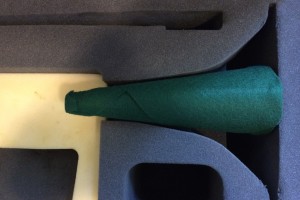
Since the majority of my recent travel has been on Air Canada, and domestically, I’ve elected to check my horn more often then trying to carry it on. With the changes to their baggage policies over the past year, Air Canada staff have been fairly aggressive in enforcing rules, and I didn’t want to risk putting my instrument on a belt loader. Because of that, I use a heavy-duty travel case designed to take a beating, “The Tank” by Diversified Cases.
Padded with a thick foam and cut to fit the trombone precisely, “The Tank” is designed to minimize any movement of the horn during travel. Memory foam surrounds the valve cluster, and allows the case to fit any configuration of valves and tubing.
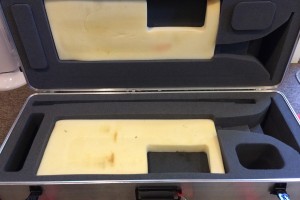
I add a series of polishing cloths to further surround the instrument, again to reduce any movement of the instrument in the case. Be careful not too add so much extra padding that you have to force the case closed, and crush your horn!
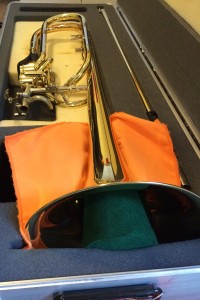
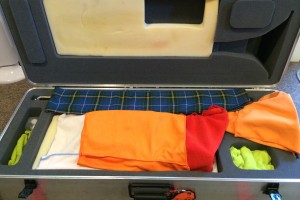
Finally, as good as any latch is, accidents can happen and a case can pop open, spilling it’s contents all over the tarmac. I’ve often seen luggage come off the conveyers in huge clear plastic bags, having split open on an impact or knocked open. Luggage straps are a great way to keep your latches shut! Be sure to run the strap over top of the latches.
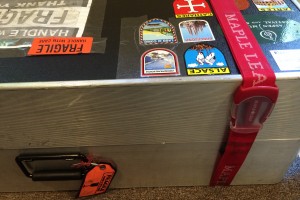
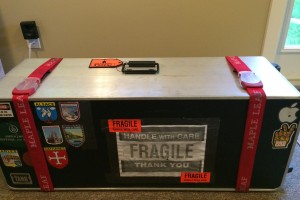
Don’t forget to add your “Fragile” markings. All sides if you can, so that nothing is missed by the baggage handlers.
There are alternatives to something like “The Tank” for travel. A number of people have found success with using an SKB Golf Case as a travel shell for their actual case. I’ve found that the SKB Staff Case fits my Marcus Bonna bass case, although I have supplemented the SKB with extra foam to ensure that my horn case does not rattle around during travel. The advantage here is the extra space for clothing or other materials, and a set of wheels that are more “all terrain” than those supplied on “The Tank”.
When you carry-on, aside from similar packing preparation, try to find out how you can board the plane ahead of other passengers. Air Canada, for instance, has their Altitude program for frequent flyers which allows for early boarding. Getting on early means you get to the overhead compartments first, while they’re empty. You can then pick a spot over your own seat. Not only is this convenient for when you are leaving, but it also means you can watch as other passengers put their baggage in the overheads. Since the checked baggage fees are so much more costly, people are trying to bring on more luggage. This means that each compartment usually ends up full, and people will try and force luggage into the full spaces. You can carefully discourage other passengers from repeatedly trying to push their luggage through your case if you can see it might happen.
4. Tracking
Of course, once you hand over your instrument you’re at the mercy of waiting until reaching your destination to see whether it actually makes it with you! Lost luggage is more common than we like to admit, and just because your instrument is “Fragile” doesn’t mean they won’t pick it to be left behind. Something I’ve done to help ease my mind is to use a small tracking tool inside my case to keep an idea of where it is!
The Tile is a small tracker than you can attach to pretty much anything, and then use their mobile software to see where your instrument is! I leave a Tile inside my case, and when I reach the plane, I open the app to see if the instrument made it into the cargo hold on my flight. Knowing that it made it with me is a huge relief, every time.

Where are you?

There you are!
5. Inspect your horn!
Due to its size and fragile tags, your horn is usually going to come through the oversize pickup, and not the baggage carousel with everything else. This is usually reassuring, as more often than not it is hand delivered to that particular area. Less reassuring is the fact that the oversize luggage seems to be the last thing that is done, playing on your fears. (Check your Tile!)
Once your instrument arrives, be sure to open up your case and check it right then and there! Any issues with the instrument, or damages to the case itself, must be brought up with the airline baggage staff in the airport and not afterwards once you’ve actually arrived at your destination. The airline will try to avoid any cost and repairs responsibility if they can, including making the assertion that the damage occurred after the instrument was out of their possession.
I’ve experienced a few cases of damage to my case, and when I’ve made the claim immediately in my arrival airport, Air Canada has been nothing but accommodating in getting the case repaired. There has been no cost to me beyond my time and inconvenience. In conversations with baggage staff during one of these claims, I was informed that it is difficult to get a replacement case through the airline, due to perceived “wear and tear” from regular use. If repairable, get it done!
If the worst has happened and there is damage, be sure to report it and start the claims process. In my sole case of a damaged horn years ago, I had great success engaging my insurance company to act as a go-between myself and the airline. A good broker can be a great resource to encourage the completion of a claim. Pictures taken of the damage immediately, and compared to your initial pictures, can also help back up your claim for repairs or replacement.
There’s no sure thing with travelling with an irreplaceable musical instrument. That risk is always going to be there in some degree or form. These measures act more like risk management to reduce your own personal level of concern. In the end, we end up still at the mercy of the airline, its staff, and the other passengers. Do your research and preparation and protect your horn as best as possible under the circumstances!
– Nick Sullivan
